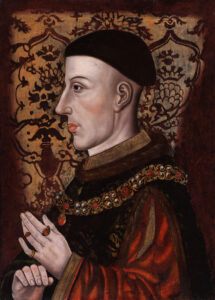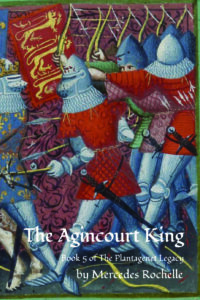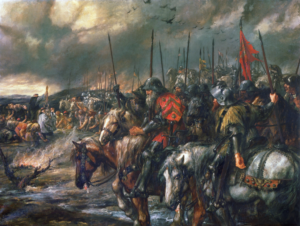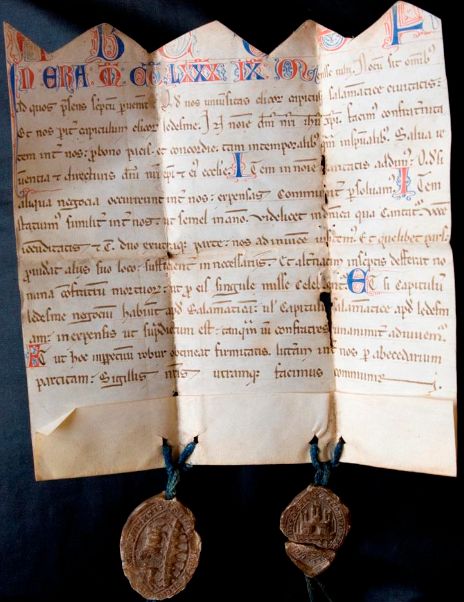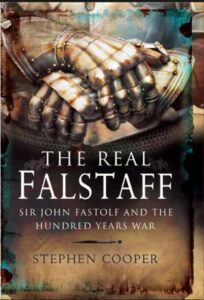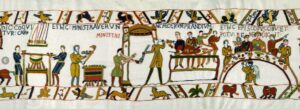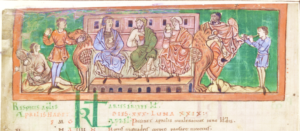
I think Henry V was one of the more inscrutable kings—not least because the great bard took him in hand. Shakespeare’s play has, of course, immortalized Henry, giving him a fabulous speech on St. Crispin’s Day that still sends chills down our spine. Well, you know what I mean. There is no doubt that Henry V elevated the Lancastrians from usurpers to heroes, which was very possibly the reason he launched his French invasion in the first place. God was on his side, and after Agincourt no one dared suggest he didn’t deserve to sit on the throne.
If you had a chance to read my previous novel, THE ACCURSED KING, you would have seen Henry in his formative years. He was not the favorite son; the one-year younger Thomas filled that slot. I suspect this was because Thomas was the only son to accompany Henry Bolingbroke when he was exiled by Richard II. Before that, their father was so busy gallivanting around Europe he had very little time to spend with his family. Young Henry’s mother died in childbirth when he was eight, and the children were farmed out to relatives. During his father’s exile, twelve year-old Henry served as hostage to the king, and he accompanied Richard II to Ireland. He was favoured by the childless king, and Richard knighted him on campaign. When the king was usurped, young Henry was appalled, and I’m sure the stress between him and his father was intense. As first-born, Henry was given the titles due to the heir of the throne, and he was pragmatic enough to accept what fate had handed down to him. But as soon as he was crowned, one of the first things he did was give Richard II a proper burial.

As Prince of Wales, Henry was given full responsibilities. He spent eight years subduing the rebellious Welsh, learning much about warfare in the process. In 1403, when he was seventeen, he engaged in the full-scale Battle of Shrewsbury against the Percies, where he received an arrow in the face that nearly killed him. In 1410 he actually took control of his father’s council, since Henry IV’s illness had nearly incapacitated him, though a year later he was summarily dismissed when he and his uncle Bishop Beaufort reportedly suggested Henry IV retire. Then he spent a couple of years in enforced inaction.
Shakespeare gives us a lively tale of young Hal traipsing around town, drinking, causing trouble, and hanging about with disreputable characters (sorry, Falstaff was a made-up charlatan). As usual, this version of Hal went down in the history books as fact. But really, between fighting the Welsh and running the government, when could he have had the time? It’s possible that the two years he was in disgrace gave him the opportunity to proverbially let his hair down. This may have been the only time in his life he had a chance to enjoy himself. But by all accounts, he really did sober up the night his father died, and redefined himself as a serious, resolute leader ready to step into his father’s shoes. I just don’t believe his personality changed. He was ready for the task, and embraced it wholeheartedly.
It is said that Henry was well-loved by his companions and retainers. He was sincerely pious—to a fault, many historians state. He surrounded himself with bishops and clerics and took them on campaign, attended three masses in a row (I think every morning, but I’m not certain). Throughout his life, he didn’t waste time with flowery orations, and gave concise, common-sense responses like “No, that’s not acceptable” or “Yes, that’s possible”. In ordinary circumstances, he was very approachable and even sociable, as records of his losses at cards attest. He loved music, played the harp, and kept a large group of minstrels at his side, even on campaign. However, when the situation called for it—like a surrender after sieges—he exhibited an arrogance that intimidated his enemies.
As a commander, he demanded absolute obedience. His army was reportedly even better behaved in France than the French soldiers; there was no random violence against peasants, women and clergy for the most part. It was his intent that the French should come to see him as a better leader than their own incompetent king. As we know from the famous incident before Agincourt, he didn’t hesitate to hang a soldier who stole a pyx from a local church. At the same time, he did his best to take care of his troops. When he lay siege in the winter, he made sure to build little wooden houses for his own soldiers to shelter in. For the most part, food and supplies were shipped over from England rather than live off the land. Rarely did his besieging army suffer the pangs of hunger.
Nonetheless, a closer look at Henry’s deeds and behavior—especially during his Norman invasion after 1417—gives us some cringe-worthy moments. It can be terribly difficult not to judge Henry from our modern point of view. He was a product of a violent society, where human lives had little value unless you were of the upper classes. Might made right, and chivalric ideals didn’t necessarily include sympathy for the downtrodden. No one gave any thought to poor farmers whose crops were devastated and homes burned to the ground. It was commonly stated that the French occupying forces actually did considerably more damage than the English (France was in the middle of a civil war when Henry invaded).

One of the more damning stains on Henry’s reputation was during the battle of Agincourt. He ordered the prisoners to be killed when he was convinced that the enemy were gathering to attack again. Many modern historians are appalled at the order, which seems ruthless in the extreme. However, this wasn’t the first time prisoners were killed on the field of battle. It happened at Aljubarrota in 1385 when John of Portugal ordered prisoners killed so they could fight the Castilians. In an even more cold-blooded example, on the morning after the battle of Halidon Hill in 1333, Edward III ordered the beheading of over 100 Scottish prisoners. There are other examples, too much to describe here. It is significant that no one can find contemporary denunciations of Henry V’s decision at Agincourt. What he did was apparently within the acceptable code of war at the time. He may have regretted the killing, but he thought it was necessary.
Later on, during his second invasion of France after 1417, Henry’s attitude became more unforgiving. After one siege, he insisted on hanging a trumpeter that repeatedly annoyed the English with his derisive blasts from the battlements. He hung Scottish prisoners after the siege at Melun because they dared fight against him. Most of these petty retributions occurred after sieges, when he was angry at the resistance that caused the deaths of many Englishmen.
I think modern historians are harder on Henry V then contemporaries. But I’ll leave you with this quote from the great K.B. McFarlane, mid-century Oxford historian whose research was unparalleled: “It pleases lesser mortals to detect the Achilles’ heel of the great ones that live in the world’s eye; but by whatever standards he is judged, Henry was superlatively gifted: his only weakness was the physical one from which he died. He was born to rule and to conquer… Take him all round and he was, I think, the greatest man that ever ruled England.” (Lancastrian Kings and Lollard Knights) That’s informed judgment I would find it hard to argue with!

